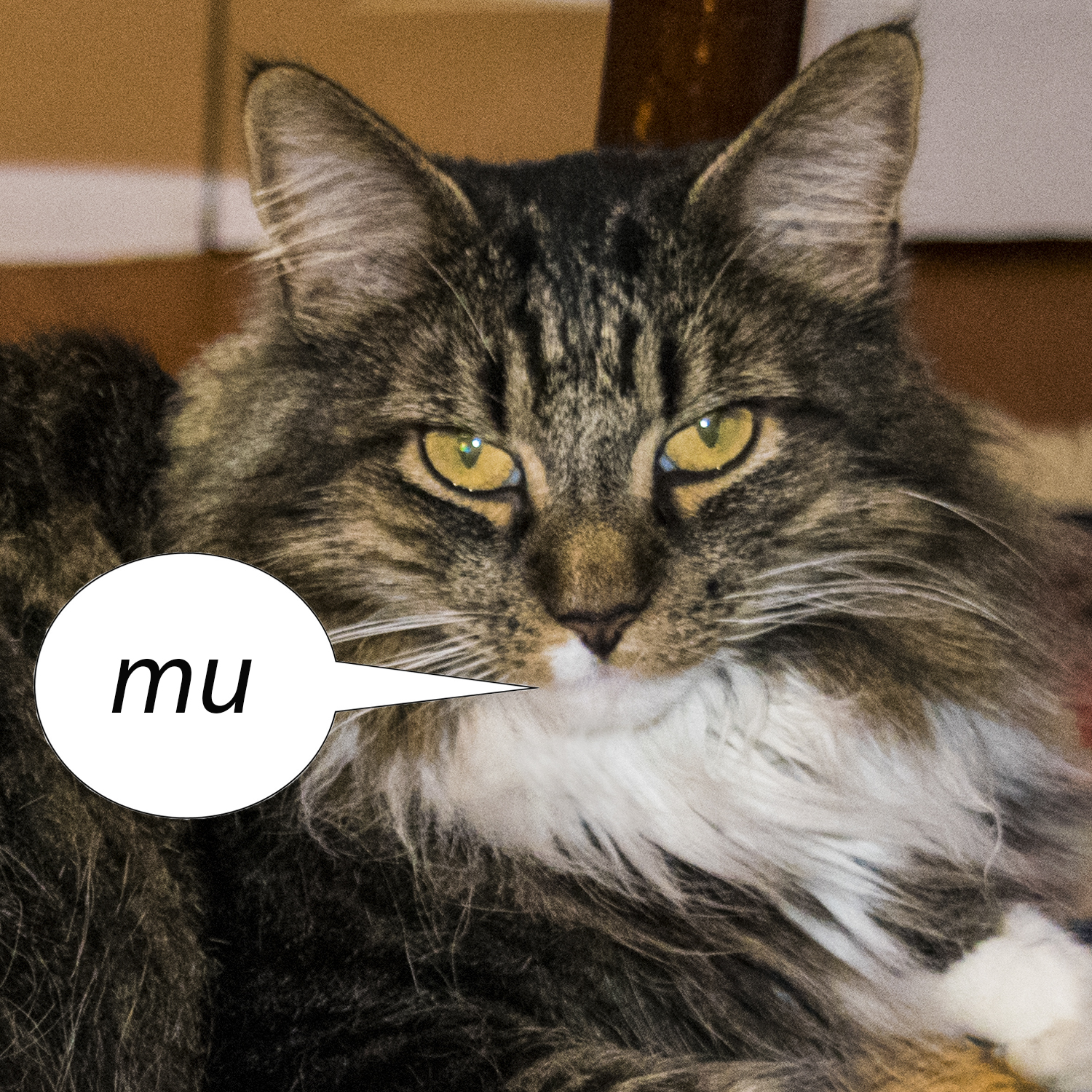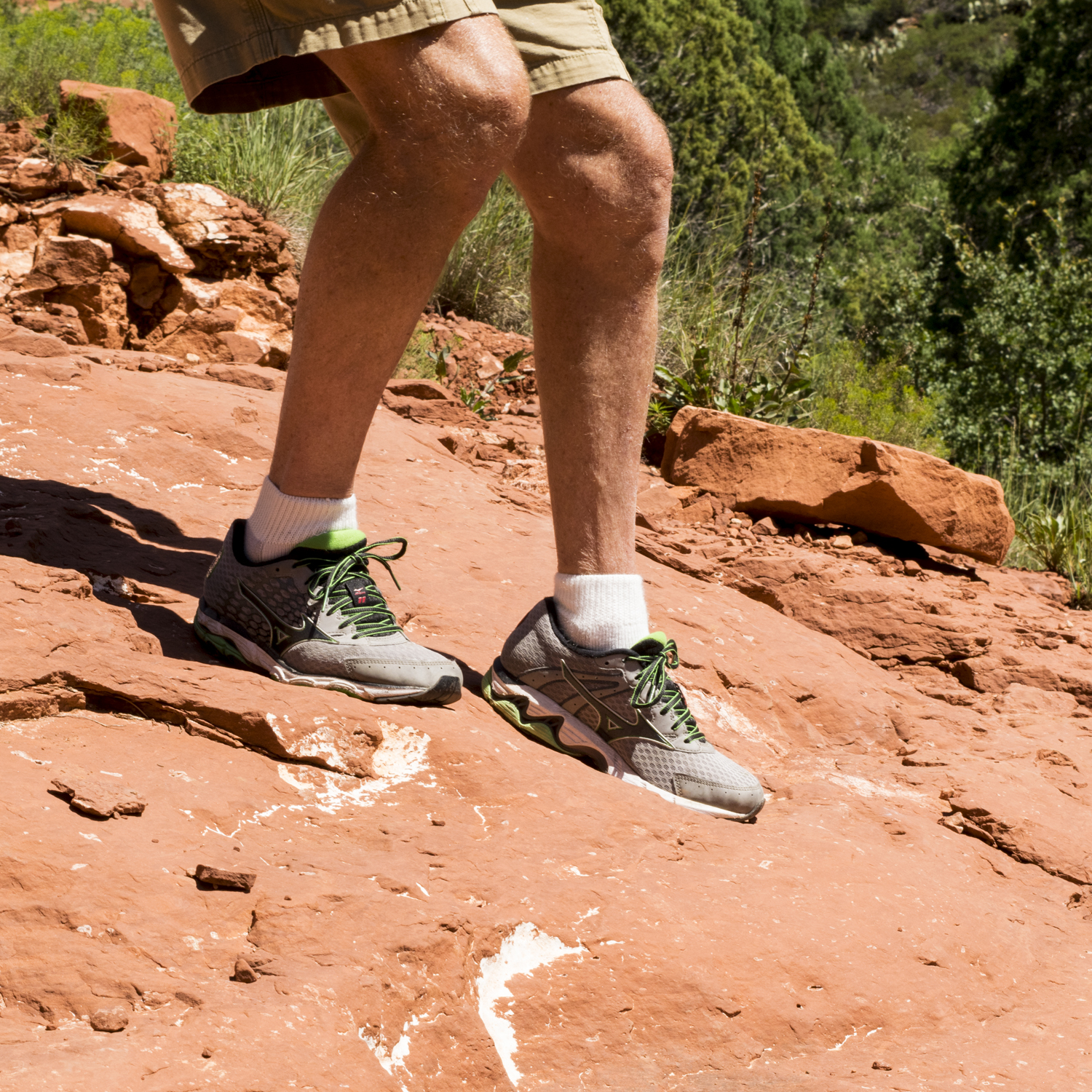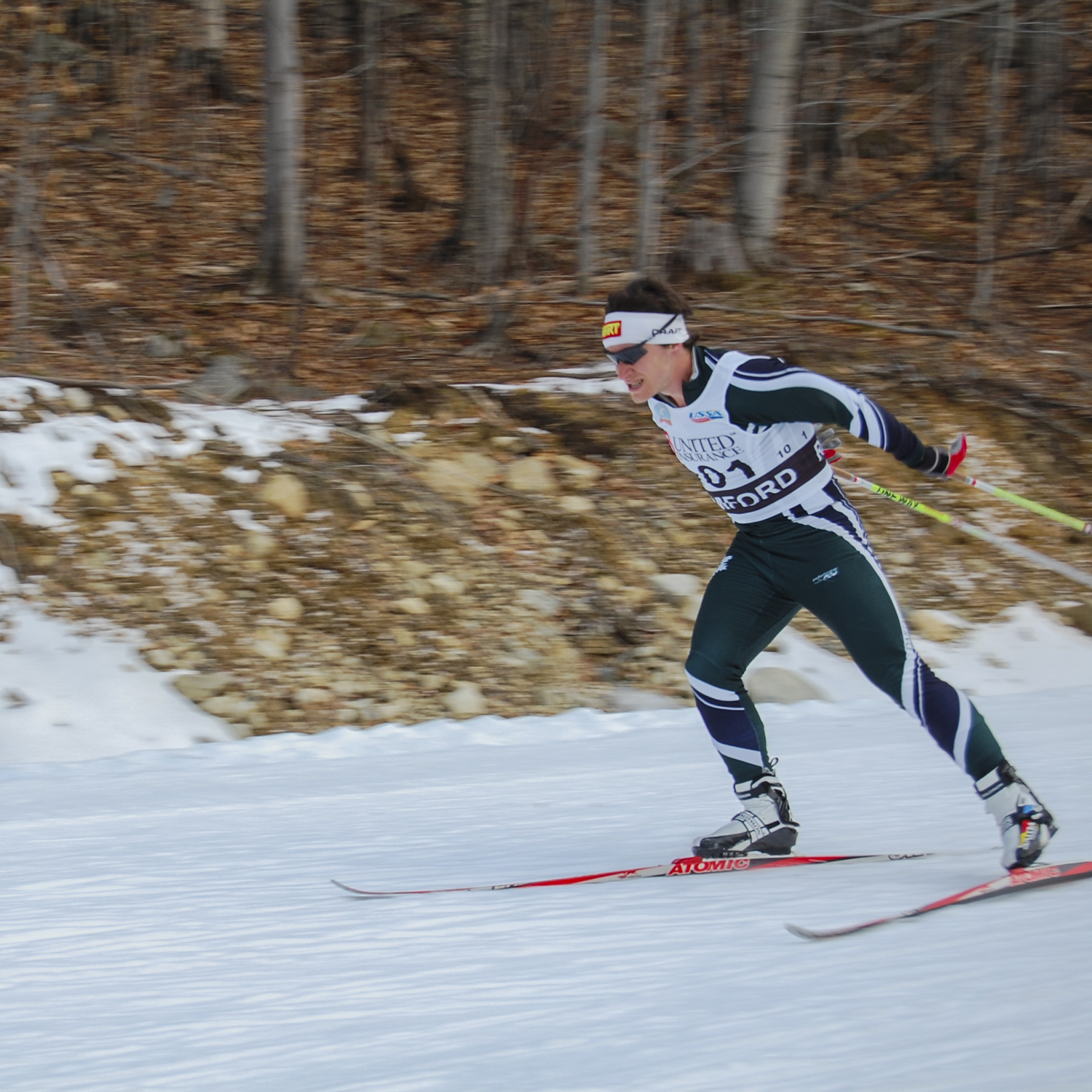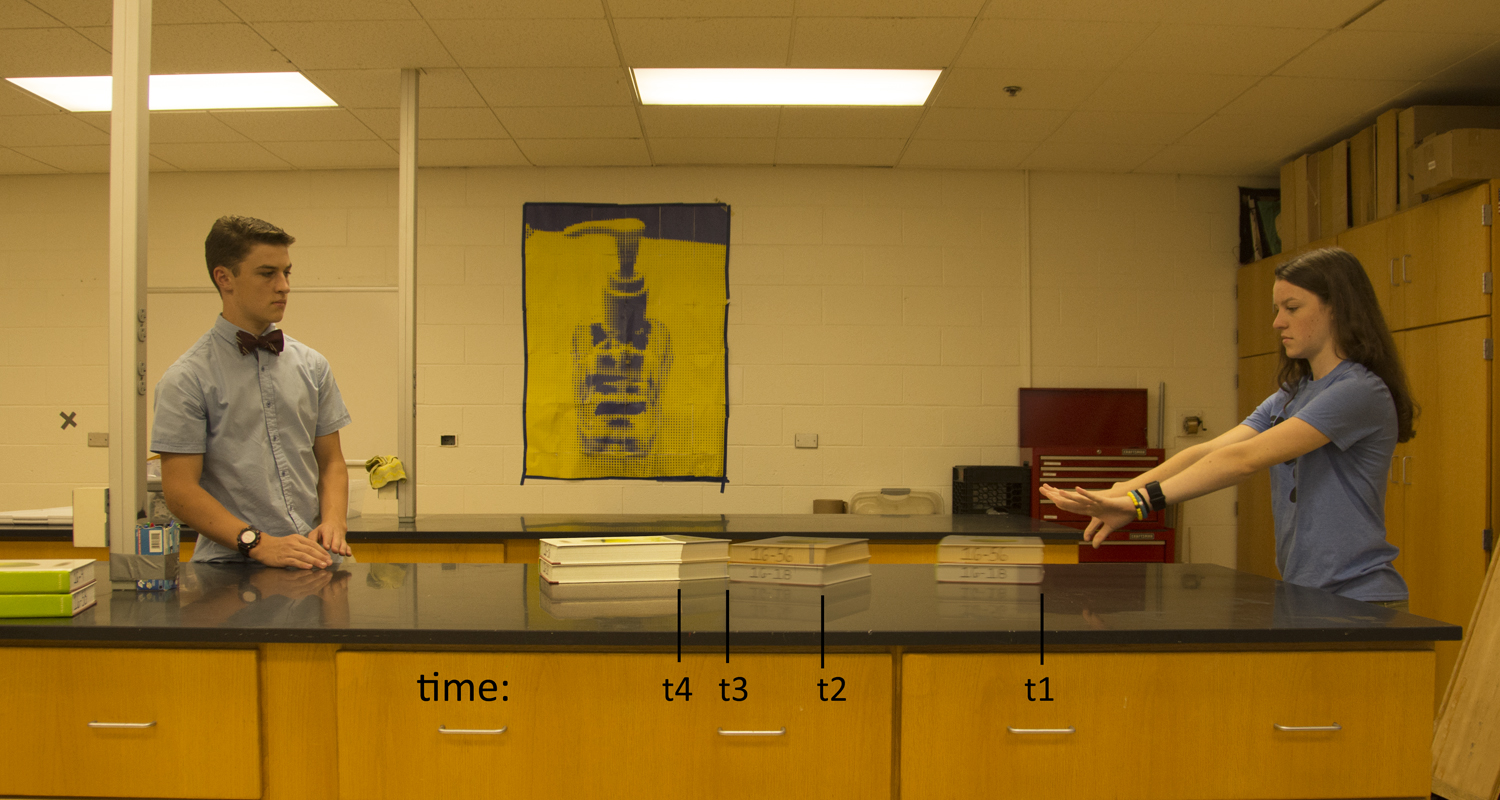More ForceS
As we have seen, there are many kinds of forces: pushing, pulling, lifting, and weight, for example, and these forces work to generate motion. There are two other kinds of force that are usually present: friction and air resistance, and these forces work to oppose motion. In real life situations, many forces act together. They combine to form a total force or a net force, which causes the actual motion that we see. In this section, we will look at what causes friction and air resistance. We will then show how these and other forces are combined to form the net force.
Friction
Friction and air resistance always act in a direction opposite to the direction of travel, so they cause moving things to slow down. While an object needs to be moving for air resistance to act, friction can act even when something is sitting still.
If you slide a book across a smooth table, it will slow down pretty quickly and stop. If you hit a hockey puck on the ice, it will hardly slow down at all. The table exerts a large frictional force on the book, but the ice doesn't exert nearly as much on the puck. There are two things at work that explain why a sliding book is different from a sliding hockey puck. One has to do with the nature of the sliding surfaces (slippery or rough, for example). The other has to do with how much one surface has to work to support the sliding object.
Let's start with the nature of the sliding surfaces. Any two surfaces that come into contact are described by a coefficient of friction. This term is quite a mouthful! Scientists and engineers use a shorthand term for the coefficient of friction: mu. This is the spelling of a Greek letter, like alpha and beta, and it is pronounced "mew". Rough surfaces that don't slide easily have a large value of mu while slick surfaces that do slide easily have a small value of mu.
Here are some examples of lots of mu (left) and not much mu (right). Running shoes and hiking boots have thick rubber tread on the bottom and this generates lots of mu on most surfaces (except ice). With all of that mu, hikers can be confident that they won't slip when they are going up or down steep slopes. Skiers, meanwhile, use special wax on the bottoms of their skis to make them glide across the snow with very little mu. This is particularly helpful when they are skiing up hill!
Of course, sometimes there's not enough mu when you need it! This happens a lot in snowstorms if you don't have good snow tires. It also happens on muddy dirt roads and on paved roads with a thick covering of water. In the picture below, the front wheel is supposed to drive the car forward. Because there's not enough mu, the front wheel spins while the back wheel just sits there.
The tire on the front wheel doesn't have enough mu.
If you push on a wall with a force F1, it will push back on you with a normal force, N, that is perpendicular to the wall.
The second thing that impacts the frictional force has to do with how one surface supports the other. Remember Newton's Third Law? It says that for every force there is an equal and opposite force. We showed a picture of a hockey player pushing off the wall when we introduced Newton's Third Law. In that example, the wall pushes back on the skater. We called the pushing-back force F2 earlier, but we will now give it a more official name: the normal force, N. Because it is a force, the normal force is represented using a vector (or arrow). The length of the vector represents the size of the pushing-back force and the arrow points in a direction that is always at a right angle (perpendicular) to the surface that pushes back.
For a lamp on a table, the normal force is equal and opposite to the weight of the lamp.
Suppose the force is the weight of a lamp sitting on a table. The equal and opposite force is the one exerted by the table to support the lamp.
It is sometimes a challenge to visualize the normal force vector, because it should be drawn inside the object being supported. Sometimes dotted lines are used inside a drawing or photo of the object. For the picture of the lamp, the vector is shadowy inside the lamp but clear when it bursts out the top.
The normal force and the coefficient of friction, mu, are equally important in determining the frictional force. One curious thing to note is that while the normal force is in a direction perpendicular to the surface, the frictional force is always along the surface! If an object is moving, the direction of the frictional force is always opposite the direction of motion, no matter what that direction is. If an object is not moving, there may be some force trying to get it to move and the frictional force acts opposite the direction of that force. If you look back at the hiker standing on the sloping rocks, gravity is trying to slide the hiker down the hill but friction acts in the opposite direction to keep him stationary.
You can demonstrate the role of the normal force by sliding some books across a table. Let's first consider one book. Start by giving a medium-sized push on the book for some short time. (Too big a push will send it flying off the table and too little a push won't move it much at all.) Your push accelerates the book and brings it up to some velocity, v1, when you let go. After you let go, the only force acting on the book in the direction of travel is the frictional force between the book and table. The book will slide for a short time and come to a stop. The velocity v1 is the initial velocity at the start of this slowing-down motion.
Pushing on a book accelerates it to a velocity, v1, after which it slows down and stops.
The frictional force opposes the motion and depends only on mu and the normal force. Looking at the book's position at 7 equally spaced times, labeled t1 through t7 in the image below, you can see the negative acceleration - or deceleration - caused by the frictional force. As it slows down, the book advances a shorter distance each time, as indicated by the position of the right corner. (It's more traditional to track the center of mass of the book, but the right corner shows up better.)
Starting at time t1 with velocity v1, the book slides to a stop by time t7 because of friction.
Now place a second (similar) book on top of the first. Try to give the books a push similar to the one you used for a single book - not too big and not too small. The books will start to slide as soon as you let go, but if they start with about the same initial velocity, they will stop sooner than one book did. Why? We know that the frictional force acting on the books depends on mu and the normal force. Since mu depends on the surfaces of the bottom book and the table, it is the same for a two-book stack as it was for a single book. The normal force is doubled, however, because it is equal and opposite the weight, which is now twice as much as before. With twice the normal force, the frictional force is now doubled, as is the deceleration. As a result, the two-book stack stops sooner than one book, assuming they start with approximately the same initial velocity.
If they start with about the same initial velocity, two books sliding across the table stop sooner than a single book.
Think about applying brakes when you are on a bike. If you apply the brakes gently (causing less frictional force), it will take longer to stop than if you apply the brakes strongly (causing more frictional force). When you slide a pile of books across the table, there is more frictional force than when you slide a single book, so the pile of books stops sooner, assuming the initial velocities are about the same.
Air Resistance
Air resistance is another force that acts to oppose motion. Unlike friction, it only exists when something is moving. You can feel air resistance when you are riding on your bike.
You can feel air resistance on your face when you ride your bike.
When you are on your bike, your body has to push the air out of the way in order to go forward. Think of Newton's Third Law. Air resistance is just the equal and opposite force that the air exerts back on you! It depends on a few things. First, it depends on the front area of you and your bike. The front area is just your size as seen by someone standing right in front of you. Second, air resistance depends on your speed of travel. Third, it depends in a somewhat complicated way on the shape of you and your bike.
Air resistance is a force, so it has a size and a direction. That direction is always opposite the direction of travel. The vector showing the air resistance is usually labeled R, but as with all vectors, it can be called whatever we want! Consider a truck and a car traveling down the highway at the same speed. The truck has a larger area facing the front (the direction of travel) than the car does, so there is more air resistance on the truck than on the car. That is, R2 is larger than R1.
The truck has more area facing forward than the car so its air resistance, R2, is larger than the car's air resistance, R1.
Next, remember back to the red truck accelerating on the entrance ramp to a highway. The truck's speed increases as it accelerates so the air resistance at the start of the entrance ramp, R1, is less than it is toward the end of the ramp, R2. When the truck goes faster, it has to move more air out of the way per second than when it is going slower, and that's why the resistance of the air is greater. There's more of it to push out of the way! The engine in a car or truck has to work harder to travel at faster speeds than at slower speeds but the increase in air resistance makes the engine have to work even harder at high speeds.
There is less air resistance on the truck moving slower, R1, than on the same truck moving faster, R2.
The shape of a car or truck also contributes to the air resistance. In general a smooth shape generates less air resistance than a boxy shape. Consider the two cars below. They are traveling at about the same speed and the front-facing area of the two cars is about the same. (The car on the left may look bigger but it is higher off the ground.) The car on the left is more boxy, so the air resistance it feels, R2, is more than that felt by the car on the right, R1.
Boxy-shaped cars, like the one on the left, usually experience more air resistance than smoothly shaped cars, like the one on the right.
A lot of 18-wheelers nowadays have special caps on top of the tractor that help deflect air from the top of the trailer. These caps have been shown to reduce air resistance. With less air resistance, the truck engine doesn't have to work as hard to drive at highway speeds, so gas mileage is improved. Shapes that are built to have reduced air resistance are called aerodynamic shapes. You can see aerodynamic shapes on things ranging from bobsleds to bicycle helmets.
The cap on top of this truck changes the shape and cuts down on air resistance.
Net Force
As mentioned earlier, friction and air resistance act in addition to other applied forces, like pushing and pulling, to determine motion. Because forces have a direction associated with them, we have to take this into account when we combine them to generate the total, or net force. Let's take a look at a few examples to understand how the forces add together.
Recall the example of sliding books across a table. We will now look at sliding a pile of four books, with four times the frictional force as a single book. The pushing force, or applied force, is shown in red and called F in the picture below. It points to the left. The frictional force, f, is shown in pink and points to the right, opposite the direction of F. Because the frictional force is less than the applied force whenever there is motion, it is often represented using a lower-case letter, like f, while an upper case letter, like F, is used for the larger force.
When you push books across a flat table, the net force, F-NET, is the applied force, F, minus the frictional force, f.
The combination of the pushing force, F, and the frictional force, f, is the net force, F-NET, shown in yellow. Its length, which represents the size of the net (or total) force, is found by subtracting the size of f from the size of F. For example, if the size of F is 5 pounds and the size of f is 1 pound, the size of F-NET would be 4 pounds. The direction of F-NET is the same as the direction of F. When vectors are added together in this manner, the process is called... wait for it... vector addition! There are a few ways to do vector addition, and they can help when there are lots of vectors or when the vectors don't line up, the way they do here.
Recall that vectors are just arrows. Each one has a head, where the arrow is, and a tail. To make them easier to deal with, you can pick them up and draw them somewhere else, as long as you don't change their length or direction. To add them, start by positioning them in a head-to-tail fashion.
Vectors can be added by placing them head to tail. The sum goes from the tail of the first to the head of the last.
The applied force vector, F (red), is redrawn in the upper left of the photo. The friction vector, f (pink), is then placed with its tail at the head of the applied force vector. The sum of these two vectors, F-NET (yellow), now goes from the tail of the first, F, to the head of the second, f. Imagine a situation where there are forces at different angles. This method can help make it easier to figure out the net force.
Frictional force can act even if there is no motion. Think about standing on a steep slope. If you are lucky, there is enough friction to hold you in place. It is easier to understand how this happens if we look at the forces at work.
The frictional force, f, balances the downhill part of your weight, W1, when you are not moving.
The first force we can identify is your weight, W, which points straight down toward the center of the earth. This vector can be broken into two parts, or components, that are perpendicular to one another. These parts are shown in the picture as W1, in green and pointing downhill, and W2, in pink, pointing down into the rocks. The direction of W1 is chosen so that it is at the same angle as the surface of the rock. The part W2 is therefore perpendicular to the surface of the rocks. The thin red lines are added to show that W1 and W2 are like two sides of a rectangle, with W along the diagonal.
Remember the normal force? It is always perpendicular to the supporting surface, so it is shown as N, in pink. What is the size of N? It is the same size as W2. It just points in the opposite direction. If you add W2 and N, they will cancel each other. If they didn't, your foot would sink into the rock or get lifted above it. Thus, there's no net force on your foot in the direction perpendicular to the surface.
Next, consider the frictional force, f. In order to keep your foot from slipping, f must be the same size as W1 and point in the opposite direction. That is, f and W1 must cancel each other, just as N and W2 do. There is no net force along the surface. Instead of having to worry about the weight vector, W, to determine your motion when you are standing on a slanted surface, you can just focus on its components, W1 and W2. For you to hold your ground and not sink into the rock or slip down it, these two components must be balanced by the frictional force and the normal force.
Of course there are lots of times when you want to be sliding down a hill rather than staying in one place! This is true if you are on a sled or a tube going down a snowy slope.
Lots of forces contribute to your motion when you are sliding down a hill.
What are the forces? As before, there is your weight - the weight of you and your friends and the tube or sled you are riding on. That weight vector, W, shown in black above, can be broken down into two components. One is along the surface, pointing downhill. It is called W1 in the picture and shown in pink. There is another component that is perpendicular to the surface and pointing down into it, but we have left that out of the picture. We have also omitted the normal force that is perpendicular to the surface and pointing up. These two forces cancel each other. We can omit them from the picture because we are only interested in the motion along the surface of the hill.
The force W1 causes your motion, but there are two forces that oppose it. The first is friction, f, shown in orange and pointing uphill. It acts between the tube and the snow. The second is air resistance, R, shown in green and pointing uphill. It pushes against your body and the tube. The combination - or sum - of W1, f, and R determines your speed of travel down the hill.
To add the forces together, the vectors are moved to the left and enlarged for better visibility. The short red lines in the enlarged view are used to help line the vectors up properly. Using the head-to-tail method, the three forces add to F-NET, shown in blue, which starts at the tail of W1 and ends at the head of R. It points downhill, which is why you can have a fun ride!
Something else happens as you slide down the hill. You accelerate because of the net force, but the air resistance, R, increases as you go faster. Pretty soon the forces f and R add up to an opposing force the same size as W1! When this happens, the net force, F-NET, is zero. You will keep sliding down the hill, but you will no longer be accelerating because there is no net force acting on you. Your velocity will remain constant for the rest of the ride. There's a name for this: terminal velocity. Falling objects, like sky divers and feathers, accelerate for a while but then float down to the earth at a constant, terminal velocity once the air resistance increases enough to balance their weight.
In summary, there are forces that make things move and forces that slow things down. If you look around, you will see all kinds of examples where friction and air resistance are adjusted to achieve a desired net force. New car designs try to minimize air resistance - and improve gas mileage - with smooth shapes. Sky divers spread their bodies out flat to increase air resistance - and lengthen their time in the air - before opening their parachutes. Grip tape is used on skate boards to increase mu and keep feet from slipping. And running water is used on water park slides to reduce mu and make you go faster. The idea is to control friction and air resistance, and therefore the net force, so that you get the best type of motion you want to have!
The net force - here with minimal air resistance and friction - determines your motion.


















